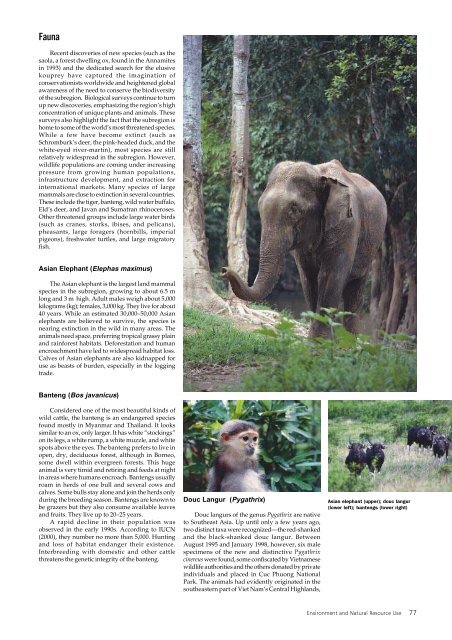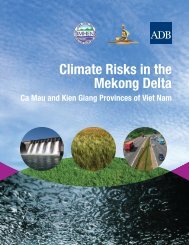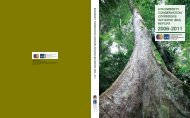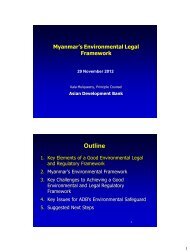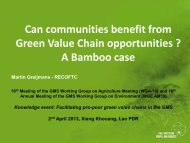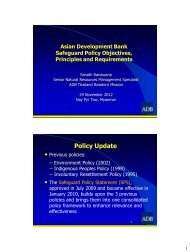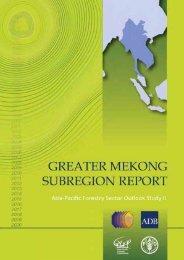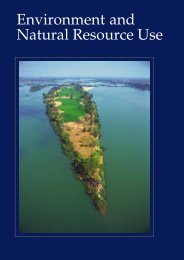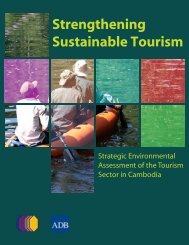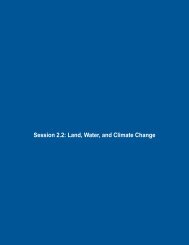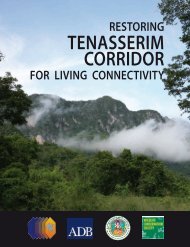You also want an ePaper? Increase the reach of your titles
YUMPU automatically turns print PDFs into web optimized ePapers that Google loves.
FaunaRecent discoveries of new species (such as thesaola, a forest dwelling ox, found in the Annamitesin 1993) and the dedicated search for the elusivekouprey have captured the imagination ofconservationists worldwide and heightened globalawareness of the need to conserve the biodiversityof the subregion. Biological surveys continue to turnup new discoveries, emphasizing the region’s highconcentration of unique plants and animals. Thesesurveys also highlight the fact that the subregion ishome to some of the world’s most threatened species.While a few have become extinct (such asSchromburk’s deer, the pink-headed duck, and thewhite-eyed river-martin), most species are stillrelatively widespread in the subregion. However,wildlife populations are coming under increasingpressure from growing human populations,infrastructure development, and extraction forinternational markets. Many species of largemammals are close to extinction in several countries.These include the tiger, banteng, wild water buffalo,Eld’s deer, and Javan and Sumatran rhinoceroses.Other threatened groups include large water birds(such as cranes, storks, ibises, and pelicans),pheasants, large foragers (hornbills, imperialpigeons), freshwater turtles, and large migratoryfish.Asian Elephant (Elephas maximus)The Asian elephant is the largest land mammalspecies in the subregion, growing to about 6.5 mlong and 3 m high. Adult males weigh about 5,000kilograms (kg); females, 3,000 kg. They live for about40 years. While an estimated 30,000–50,000 Asianelephants are believed to survive, the species isnearing extinction in the wild in many areas. Theanimals need space, preferring tropical grassy plainand rainforest habitats. Deforestation and humanencroachment have led to widespread habitat loss.Calves of Asian elephants are also kidnapped foruse as beasts of burden, especially in the loggingtrade.Banteng (Bos javanicus)Considered one of the most beautiful kinds ofwild cattle, the banteng is an endangered speciesfound mostly in Myanmar and Thailand. It lookssimilar to an ox, only larger. It has white “stockings”on its legs, a white rump, a white muzzle, and whitespots above the eyes. The banteng prefers to live inopen, dry, deciduous forest, although in Borneo,some dwell within evergreen forests. This hugeanimal is very timid and retiring and feeds at nightin areas where humans encroach. Bantengs usuallyroam in herds of one bull and several cows andcalves. Some bulls stay alone and join the herds onlyduring the breeding season. Bantengs are known tobe grazers but they also consume available leavesand fruits. They live up to 20–25 years.A rapid decline in their population wasobserved in the early 1990s. According to IUCN(2000), they number no more than 5,000. Huntingand loss of habitat endanger their existence.Interbreeding with domestic and other cattlethreatens the genetic integrity of the banteng.Douc Langur (Pygathrix)Douc langurs of the genus Pygathrix are nativeto Southeast Asia. Up until only a few years ago,two distinct taxa were recognized—the red-shankedand the black-shanked douc langur. BetweenAugust 1995 and January 1998, however, six malespecimens of the new and distinctive Pygathrixcinereus were found, some confiscated by Vietnamesewildlife authorities and the others donated by privateindividuals and placed in Cuc Phuong NationalPark. The animals had evidently originated in thesoutheastern part of Viet Nam’s Central Highlands,Asian elephant (upper); douc langur(lower left); bantengs (lower right)Environment and Natural Resource Use 77


